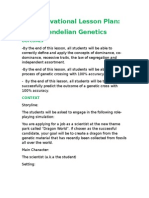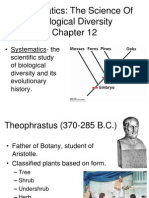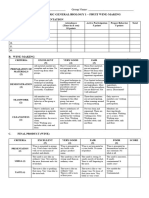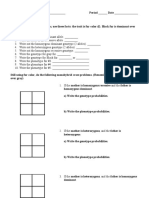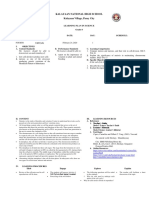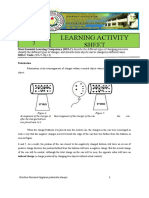Worksheet: Dihybrid Crosses
Worksheet: Dihybrid Crosses
Uploaded by
Lovie AlfonsoCopyright:
Available Formats
Worksheet: Dihybrid Crosses
Worksheet: Dihybrid Crosses
Uploaded by
Lovie AlfonsoOriginal Description:
Original Title
Copyright
Available Formats
Share this document
Did you find this document useful?
Is this content inappropriate?
Copyright:
Available Formats
Worksheet: Dihybrid Crosses
Worksheet: Dihybrid Crosses
Uploaded by
Lovie AlfonsoCopyright:
Available Formats
Name___________ ____________ Period________
Worksheet: Dihybrid Crosses
U N I T 3 : Meiosis and Mendel
Instructions: For each problem, complete a dihybrid cross and calculate the
ratios of each genotype.
Ex) A tall green pea plant (TTGG) is crossed with a short white pea plant (ttgg).
TT or Tt = tall tt = short GG or Gg = green gg = white
TG TG TG TG
tg TtGg TtGg TtGg TtGg
tg TtGg TtGg TtGg TtGg
tg TtGg TtGg TtGg TtGg
tg TtGg TtGg TtGg TtGg
16 Tall/Green : 0 Tall/White : 0 Short/Green : 0 Short/ White
1) A tall green pea plant (TTGg) is crossed with a tall green pea plant (TtGg)
___________ X ___________
____ Tall/Green : ____ Tall/White : ____ Short/Green : ____ Short/ White
Name___________ ____________ Period________
2) A tall green pea plant (TtGg) is crossed with a short white pea plant (ttgg).
___________ X ___________
____ Tall/Green : ____ Tall/white : ____ short/Green : ____ short/ white
3) A homozygous tall, homozygous green plant is crossed with a homozygous short white plant.
___________ X ___________
____ Tall/green : ____Tall/White : ____ Short/green: ____ Short/White
Name___________ ____________ Period________
5. In mammoths, assume that spotted skin (S) is dominant over non-spotted skin (s) and that
wooly hair (W) is dominant over non-wooly hair (w). Cross a mating between a heterozygous
spotted, non-wooly mammoth with a heterozygous wooly-haired, non-spotted mammoth. Give
genotypic and phenotypic ratios of offspring.
Genotypic:
Phenotypic:
6. In horses, black is dependent upon a dominant gene, B, and chestnut upon its recessive
allele, b. The trotting gait is due to a dominant gene, T, the pacing gait to its recessive allele, t. If
a homozygous black pacer is mated to a homozygous chestnut trotter, what will be the
appearance of the F1 generation?
7. In mice, the ability to run normally is a dominant trait. Mice with this trait are called running
mice (R). The recessive trait causes mice to run in circles only. Mice with this trait are called
waltzing mice (r). Hair color is also inherited in mice. Black hair (B) is dominant over brown hair
(b). For each of the following problems, determine the parent genotypes, determine possible
gametes then use a dihybrid cross to solve.
a. Cross a heterozygous running, heterozygous black mouse with a homozygous
running,
homozygous black mouse
Parental genotypes ______________
Possible gametes _____ _____ _____ _____
Offspring phenotypic ratio ________________
Name___________ ____________ Period________
b. Cross a homozygous running, homozygous black mouse with a heterozygous
running, brown mouse
Parental genotypes ______________
Possible gametes _____ _____ _____ _____
Offspring phenotypic ratio ________________
c. Cross a waltzing brown mouse with a waltzing brown mouse
Parental genotypes ______________
Possible gametes _____ _____ _____ _____
Offspring phenotypic ratio ________________
6. Set up a dihybrid cross using the following information:
Dominate allele for tall plants = D
Recessive allele for dwarf plants = d
Dominate allele for purple flowers = W
Recessive allele for white flowers = w
Cross a homozygous dominate parent (DDWW) with a homozygous recessive parent (ddww)
a. What is the probability of producing tall plants with
purple flowers?
Possible genotype(s)?
b. What is the probability of producing dwarf plants
with white flowers?
Possible genotype(s)?
c. What is the probability of producing tall plants with
white flowers?
Possible genotype(s)?
d. What is the probability of producing dwarf plants
with purple flowers?
Possible genotype(s)?
You might also like
- Evolutionary Evidence LabDocument8 pagesEvolutionary Evidence Labapi-32054921286% (14)
- Griffiths Introduction To Genetic Analysis 12th EditionDocument3,002 pagesGriffiths Introduction To Genetic Analysis 12th Editionmartin.kv40% (1)
- SAMPLE DETAILED LESSON PLAN Grade 11 (7E)Document2 pagesSAMPLE DETAILED LESSON PLAN Grade 11 (7E)Lovie Alfonso88% (41)
- Homology vs. Analogy WorksheetDocument4 pagesHomology vs. Analogy WorksheetJAY CEE DELA ROSA100% (2)
- Dihybrid Cross Practice Problems Answer KeyDocument2 pagesDihybrid Cross Practice Problems Answer KeyBarb67% (3)
- Frog Dissection Lab Sheet #1: Pre/Post Questions NameDocument2 pagesFrog Dissection Lab Sheet #1: Pre/Post Questions NameFrancis ArceoNo ratings yet
- DLL SHS Earth and Life (7E)Document3 pagesDLL SHS Earth and Life (7E)Lovie Alfonso100% (4)
- Monohybrid PracticeDocument3 pagesMonohybrid PracticeLovie Alfonso100% (1)
- A Motivation Lesson Plan Mendelian Genetics v1Document4 pagesA Motivation Lesson Plan Mendelian Genetics v1api-14397507960% (5)
- CSEC Biology - Monohybrid Cross Worksheet 1Document2 pagesCSEC Biology - Monohybrid Cross Worksheet 1Tamicka Bonnick100% (4)
- Calculating BiodiversityDocument2 pagesCalculating BiodiversityMharez Campomanes100% (1)
- TAXONOMYDocument23 pagesTAXONOMYnavinnaithani100% (1)
- Monohybrid Cross Using Beads Student ActivityDocument3 pagesMonohybrid Cross Using Beads Student ActivityLovie Alfonso100% (1)
- Monohybrid Cross Using Beads Student ActivityDocument3 pagesMonohybrid Cross Using Beads Student ActivityLovie Alfonso100% (1)
- Hibridación y Determinación Del Patrón de Herencia Del GuppyDocument23 pagesHibridación y Determinación Del Patrón de Herencia Del GuppyJUANnn100No ratings yet
- Evolution and Its EvidenceDocument17 pagesEvolution and Its EvidenceDarwin NoolNo ratings yet
- Chemical and Nervous Control Part 1 T.GDocument5 pagesChemical and Nervous Control Part 1 T.GMarichu Cayabyab100% (2)
- Monohybrid Cross WorksheetDocument2 pagesMonohybrid Cross WorksheetLovie Alfonso0% (1)
- Rubrics For Fruit Wine MakingDocument1 pageRubrics For Fruit Wine MakingMary Vi D. Dela Cruz100% (1)
- TaxonomyDocument56 pagesTaxonomyKrezia Mae SolomonNo ratings yet
- Dihybrid Crosses Worksheet KEYDocument2 pagesDihybrid Crosses Worksheet KEYJennifer Shawki100% (1)
- General Biology 2-Lesson 2: Sex Linkage and RecombinationDocument5 pagesGeneral Biology 2-Lesson 2: Sex Linkage and RecombinationERLYN NANGITNo ratings yet
- Scie 8 WHLP QTR 4 WK 2-3Document3 pagesScie 8 WHLP QTR 4 WK 2-3EyphRhylleNo ratings yet
- Activity Sheets Mendelian GeneticsDocument5 pagesActivity Sheets Mendelian GeneticsGelaii Espina GaviolaNo ratings yet
- Science First Quarter Bco Grade-9Document3 pagesScience First Quarter Bco Grade-9Mycoh SamsonNo ratings yet
- Activity 2 - Cell CycleDocument3 pagesActivity 2 - Cell CycleNick Andrew boholNo ratings yet
- Non-Mendelian GeneticsDocument18 pagesNon-Mendelian GeneticsKristina CalejesanNo ratings yet
- Cladogram Lesson PlanDocument5 pagesCladogram Lesson Planapi-665322772No ratings yet
- Week 9 10 Patterns of Descent With ModificationDocument13 pagesWeek 9 10 Patterns of Descent With ModificationKiel Tj Evangelista100% (1)
- Nardia Harley - Monohybrid Practice ProblemsDocument3 pagesNardia Harley - Monohybrid Practice ProblemsNardia HarleyNo ratings yet
- Subject Orientation Grade 11 Gen Bio UpdatedDocument2 pagesSubject Orientation Grade 11 Gen Bio UpdatedArlance Sandra Marie Medina100% (1)
- Biodiversity DLPFor Final DemoDocument17 pagesBiodiversity DLPFor Final DemoMaricel PenaNo ratings yet
- Homeostasis Feedback MechanismDocument36 pagesHomeostasis Feedback MechanismJessmay OlivarNo ratings yet
- Quiz - P1 - Evolution and Biodiversity - 2021Document6 pagesQuiz - P1 - Evolution and Biodiversity - 2021viona sabelaNo ratings yet
- Biology2 Q3 Module 4 Evidences of EvolutionDocument21 pagesBiology2 Q3 Module 4 Evidences of EvolutionDrew MalubagNo ratings yet
- Lesson Plan in ScienceDocument17 pagesLesson Plan in ScienceJayson P. Bequillo100% (1)
- Mitosisand Meiosis PPTDocument33 pagesMitosisand Meiosis PPTShanna RaineNo ratings yet
- STEM - Biology 1 CG - With Tagged Sci Equipment PDFDocument8 pagesSTEM - Biology 1 CG - With Tagged Sci Equipment PDFKOUJI N. MARQUEZNo ratings yet
- Activity Plan (Plant Tissues)Document3 pagesActivity Plan (Plant Tissues)Gomez Agustin Leslie100% (1)
- Lesson 8 - Membrane Transport - Passive TransportDocument3 pagesLesson 8 - Membrane Transport - Passive TransportEarl Caesar Quiba PagunsanNo ratings yet
- Genetics PowerpointDocument22 pagesGenetics PowerpointAditya VaishnavNo ratings yet
- Name: Josephine Cabag - Avendano Quarter: 4 Observation No. - Grade Level and Section: 11 - STEM Date: June 10, 2021Document5 pagesName: Josephine Cabag - Avendano Quarter: 4 Observation No. - Grade Level and Section: 11 - STEM Date: June 10, 2021Jho CabagNo ratings yet
- Science 8 2nd Quarter ReviewerDocument5 pagesScience 8 2nd Quarter ReviewerMartin AlvinNo ratings yet
- Week 8 - BiodiversityDocument18 pagesWeek 8 - BiodiversityLorelyn VillamorNo ratings yet
- DLP April 3 GenBio2Document2 pagesDLP April 3 GenBio2sherlockdrnNo ratings yet
- Lesson Plan in Biotechniques (Staining)Document13 pagesLesson Plan in Biotechniques (Staining)Ronel Pasalo Medina BatanganNo ratings yet
- Concept of Species Lesson PlanDocument8 pagesConcept of Species Lesson PlanMelvin Earl AgdaNo ratings yet
- Semi-Detailed Lesson PlanDocument3 pagesSemi-Detailed Lesson PlanVismay Mona AttarNo ratings yet
- 10.5 Modern Evidence of Evolution PDFDocument4 pages10.5 Modern Evidence of Evolution PDFAngela Foulger-RichardsonNo ratings yet
- Developmental Biology Practice ExamDocument10 pagesDevelopmental Biology Practice ExamNerdyMiggit100% (1)
- Science Lesson Plan: Target OutcomesDocument2 pagesScience Lesson Plan: Target Outcomesapi-527267271No ratings yet
- Lesson Plan Protista FixDocument13 pagesLesson Plan Protista FixRichard Tañada RosalesNo ratings yet
- Detailed Lesson Plan in Grade 11 Earth and Life ScienceDocument7 pagesDetailed Lesson Plan in Grade 11 Earth and Life Sciencemedsdelfrancis.cenizaNo ratings yet
- Pedigree Analysis GGLDocument14 pagesPedigree Analysis GGLLloaana 12No ratings yet
- Lesson 8 Non Mendelian GeneticsDocument21 pagesLesson 8 Non Mendelian GeneticsLorna Lordan100% (1)
- Learning Activity Sheet: Science 7Document5 pagesLearning Activity Sheet: Science 7malouNo ratings yet
- Pedigree Analysis and PracticeDocument2 pagesPedigree Analysis and PracticeMariano EdzNo ratings yet
- The Nature of Force: Grade 8 PhysicsDocument22 pagesThe Nature of Force: Grade 8 PhysicsAlicia FelicianoNo ratings yet
- Theories of Evolution WorksheetDocument3 pagesTheories of Evolution WorksheetManroop NijjarNo ratings yet
- Evidences of EvolutionDocument14 pagesEvidences of Evolutionmoonshyne100% (2)
- Dihybrid Cross WSDocument6 pagesDihybrid Cross WSy. k.No ratings yet
- Keshav Malhotra - Dihybrid CrossDocument3 pagesKeshav Malhotra - Dihybrid Crossneliwok622No ratings yet
- 4.04 Dihybrid Cross WorksheetDocument2 pages4.04 Dihybrid Cross WorksheetnunyaNo ratings yet
- Genetics Workbook 2021-22Document65 pagesGenetics Workbook 2021-22HAYEON CHOINo ratings yet
- Worksheet: Mendelian Patterns of Inheritance: (Remember To Use The Letter of The Dominant Trait)Document2 pagesWorksheet: Mendelian Patterns of Inheritance: (Remember To Use The Letter of The Dominant Trait)Ma Jovi Zamora AbusoNo ratings yet
- Practice with Prepositions in Everyday English, Advanced LevelFrom EverandPractice with Prepositions in Everyday English, Advanced LevelRating: 1 out of 5 stars1/5 (1)
- DLL The Earth's InteriorDocument4 pagesDLL The Earth's InteriorLovie AlfonsoNo ratings yet
- SC8 w32Document9 pagesSC8 w32Lovie AlfonsoNo ratings yet
- Science 8Document9 pagesScience 8Lovie AlfonsoNo ratings yet
- Science 8 DLLDocument9 pagesScience 8 DLLLovie Alfonso0% (1)
- DLL msg18 NewDocument101 pagesDLL msg18 NewLovie AlfonsoNo ratings yet
- Periodic Table ActivityDocument11 pagesPeriodic Table ActivityLovie AlfonsoNo ratings yet
- DLP Demonstration TeachingDocument2 pagesDLP Demonstration TeachingLovie AlfonsoNo ratings yet
- SC8 w29Document6 pagesSC8 w29Lovie AlfonsoNo ratings yet
- Sample Detailed Lesson Plan Grade 11 (7e)Document1 pageSample Detailed Lesson Plan Grade 11 (7e)Lovie AlfonsoNo ratings yet
- DLL Demo Print DecDocument4 pagesDLL Demo Print DecLovie AlfonsoNo ratings yet
- DLP Demonstration TeachingDocument2 pagesDLP Demonstration TeachingLovie AlfonsoNo ratings yet
- AP BIO Hardy Weinberg Questions-KeyDocument3 pagesAP BIO Hardy Weinberg Questions-KeyCasey LynchNo ratings yet
- CytogeneticsDocument17 pagesCytogeneticsLee LuceroNo ratings yet
- Ambitious Inter 2 Biology (Taleem Asaan)Document16 pagesAmbitious Inter 2 Biology (Taleem Asaan)talhagmaqsood97No ratings yet
- NEET 2020 Biology SyllabusDocument10 pagesNEET 2020 Biology Syllabuspalash mathurNo ratings yet
- Devpsych ReinforcementDocument19 pagesDevpsych ReinforcementDivine Menchu100% (1)
- E-Marking-Notes-Biology-X(0)Document20 pagesE-Marking-Notes-Biology-X(0)areeshaamin67No ratings yet
- Genetics Long QuizDocument4 pagesGenetics Long QuizPaul Stephen SorianoNo ratings yet
- 1st-4th Quarter Test - Science 8Document3 pages1st-4th Quarter Test - Science 8Ma. Elpidia Caridad TuazonNo ratings yet
- Mid Term Study Guide For 2022 Without EcologyDocument8 pagesMid Term Study Guide For 2022 Without EcologyAniya HarriottNo ratings yet
- PsychologyDocument102 pagesPsychologyJac FloresNo ratings yet
- Life Sciences DictionaryDocument10 pagesLife Sciences DictionarySdw3sh10 RSANo ratings yet
- Download ebooks file Biology: Concepts and Applications Cecie Starr all chaptersDocument55 pagesDownload ebooks file Biology: Concepts and Applications Cecie Starr all chapterszeadnajarila100% (1)
- Chapter 3 Heredity and VariationDocument14 pagesChapter 3 Heredity and Variationuncleya07100% (1)
- 8 21 The Diagram Shows Four Cells.: (Turn OverDocument44 pages8 21 The Diagram Shows Four Cells.: (Turn Over19Y1H GAO CHENZHANGNo ratings yet
- Download full Genetics : analysis & principles 6th Edition Robert J. Brooker ebook all chaptersDocument55 pagesDownload full Genetics : analysis & principles 6th Edition Robert J. Brooker ebook all chapterssobeyoseth43100% (1)
- Genetics Practice ProblemsDocument6 pagesGenetics Practice Problemskoolgirl559No ratings yet
- Tanay Samnani - 23-Sex-Linked Codominant Traits Practice Problems H-Bio Numata 2023-2024Document7 pagesTanay Samnani - 23-Sex-Linked Codominant Traits Practice Problems H-Bio Numata 2023-2024Aryan GantiNo ratings yet
- Wa0008Document8 pagesWa0008Akshat हिंदूNo ratings yet
- Botany SyllabusDocument55 pagesBotany Syllabussailaja kontiliNo ratings yet
- Genetics Problems 11Document10 pagesGenetics Problems 11Antonio López JiménezNo ratings yet
- Precision Medicine Integrating Whole-Genome SequencingDocument10 pagesPrecision Medicine Integrating Whole-Genome SequencingChristopher NorrieNo ratings yet
- GCSE Edexcel Biology June 22 1H QPDocument28 pagesGCSE Edexcel Biology June 22 1H QPAaron ZziwaNo ratings yet
- TestDaily分享 markscheme SL paper2Document54 pagesTestDaily分享 markscheme SL paper2gary gazaNo ratings yet
- SexLinked FredWilmaDocument5 pagesSexLinked FredWilmaJennifer ZhuNo ratings yet
- Epistasis Answer KeyDocument5 pagesEpistasis Answer KeyIs noorNo ratings yet
- Animal Science1Document16 pagesAnimal Science1HAZEL BADARNo ratings yet
- Wailing Biology X High School (SPM 2021 Intensive Class) QuestionDocument17 pagesWailing Biology X High School (SPM 2021 Intensive Class) Question阿芊No ratings yet
- Life Science Final Exam Review-May 2015Document8 pagesLife Science Final Exam Review-May 2015api-230330590No ratings yet








